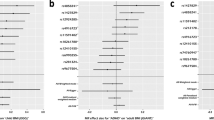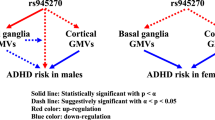Abstract
Recent animal research suggests that brain-derived neurotrophic factor (BDNF), may mediate response to different environmental stimuli. In this paper, we evaluated the possible role of BDNF as a moderator of attention deficit hyperactivity disorder (ADHD) in the context of different socioeconomic classes. We genotyped ten single nucleotide polymorphisms (SNPs) in and around BDNF in 229 families and evaluate whether there are SNP-by-socioeconomic status (SES) interactions for attention deficit hyperactivity. We developed three quantitative phenotypes for ADHD from nine inattentive and nine hyperactive-impulsive symptoms that were used in SNP-by-SES interaction analyses using a new methodology implemented in the computer program PBAT. Findings were adjusted for multiple comparisons using the false discovery rate. We found multiple significant SNP-by-SES interactions using the inattentive symptom count. This study suggests that different SES classes may modify the effect of the functional variant(s) in and around BDNF to have an impact on the number of ADHD symptom counts that are observed. The two exons within BDNF represent potential functional variants that may be causing the observed associations.
Similar content being viewed by others
References
Achenbach TM, McConaughy SH (1987) Empirically based assessment of child and adolescent psychopathology: practical applications. Sage Publications, Newbury Park
Barrett JC, Fry B, Maller J, Daly MJ (2005) Haploview: analysis and visualization of LD and haplotype maps. Bioinformatics 21:263–265
Bath KG, Lee FS (2006) Variant BDNF (Val66Met) impact on brain structure and function. Cogn Affect Behav Neurosci 6:79–85
Benjamini Y, Hochberg Y (1995) Controlling the false discovery rate: a practical and powerful approach to multiple testing. J R Stat Soc 57:289–300
Berton O, McClung CA, Dileone RJ, Krishnan V, Renthal W, Russo SJ, Graham D, Tsankova NM, Bolanos CA, Rios M, Monteggia LM, Self DW, Nestler EJ (2006) Essential role of BDNF in the mesolimbic dopamine pathway in social defeat stress. Science 311:864–868
Biederman J, Faraone SV, Keenan K, Benjamin J, Krifcher B, Moore C, Sprich-Bukminister S, Ugaglia K, Jellinek MS, Steingard R, Spencer T, Norman D, Kolodny R, Kraus I, Perrin J, Keller MB, Tsuang MT (1992) Further evidence for family-genetic risk factors in attention deficit hyperactivity disorder. Patterns of comorbidity in probands and relatives in psychiatrically and pediatrically referred samples. Arch Gen Psychiatry 49:728–738
Biederman J, Milberger S, Faraone SV, Kiely K, Guite J, Mick E, Ablon S, Warburton R, Reed E (1995) Family-environment risk factors for attention deficit hyperactivity disorder: a test of Rutter’s indicators of adversity. Arch Gen Psychiatry 52:464–470
Biederman J, Faraone SV, Monuteaux MC (2002) Differential effect of environmental adversity by gender: Rutter’s index of adversity in a sample of boys and girls with and without ADHD. Am J Psychiatry 159:1556–1562
Bor W, Najman JM, Andersen MJ, O’Callaghan M, Williams GM, Behrens BC (1997) The relationship between low family income and psychological disturbance in young children: an Australian longitudinal study. Aust N Z J Psychiatry 31:664–675
Breton J, Bergeron L, Valla J, Lepine S, Houde L, Gaudet N (1995) Do children aged 9 through 11 years understand the DISC version 2.25 questions? J Am Acad Child Adolesc Psychiatry 34:946–956
Buetow KH, Edmonson M, MacDonald R, Clifford R, Yip P, Kelley J, Little DP, Strausberg R, Koester H, Cantor CR, Braun A (2001) High-throughput development and characterization of a genomewide collection of gene-based single nucleotide polymorphism markers by chip-based matrix-assisted laser desorption/ionization time-of-flight mass spectrometry. Proc Natl Acad Sci USA 98:581–584
Cantwell DP (1972) Psychiatric illness in the families of hyperactive children. Arch Gen Psychiatry 27:414–417
Cantwell DP (1975) Genetics of hyperactivity. J Child Psychol Psychiatry 16:261–264
Chadwick O, Taylor E, Taylor A, Heptinstall E, Danckaerts M (1999) Hyperactivity and reading disability: a longitudinal study of the nature of the association. J Child Psychol Psychiatry 40:1039–1050
Costello EJ, Angold A, Burns BJ, Stangl DK, Tweed DL, Erkanli A, Worthman CM (1996) The great smoky mountains study of youth, goals, design, methods, and the prevalence of DSM-III-R disorders. Arch Gen Psychiatry 53:1129–1136
Dohrenwend BP, Levav I, Shrout PE, Schwartz S, Naveh G, Link BG, Skodol AE, Stueve A (1992) Socioeconomic status and psychiatric disorders: the causation-selection issue. Science 255:946–952
Doyle AE, Faraone SV, DuPre EP, Biederman J (2001) Separating attention deficit hyperactivity disorder and learning disabilities in girls: a familial risk analysis. Am J Psychiatry 158:1666–1672
Edelbrock C, Costello AJ, Dulcan MK, Kalas R, Conover NC (1985) Age differences in the reliability of the psychiatric interview of the child. Child Dev 56:265–275
Egan MF, Kojima M, Callicott JH, Goldberg TW, Kolachana BS, Bertolino A, Zaitsev E, Gold B, Goldman D, Dean M, Lu B, Weinberger DR (2003) The BDNF Val66Met polymorphism affects activity-dependent secretion of BDNF and human memory and hippocampal function. Cell 112:257–269
Faraone S, Biederman J, Lehman BK, Keenan K, Norman D, Seidman L, Kolodny R, Kraus I, Perrin J, Chen W (1993) Evidence for the independent familial transmission of attention deficit hyperactivity disorder and learning disabilities: results from a family genetic study. Am J Psychiatry 150:891–895
Faraone S, Biederman J, Milberger S (1994) An exploratory study of ADHD among second-degree relatives of ADHD children. Biol Psychiatry 35:398–402
Faraone SV, Tsuang D, Tsuang MT (1999) Genetics of mental disorders: a guide for students, clinicians, and researchers. Guilford, New York
Faraone SV, Perlis RH, Doyle AE, Smoller JW, Goralnick JJ, Holmgren MA, Sklar P (2005) Molecular genetics of attention-deficit/hyperactivity disorder. Biol Psychiatry 57:1313–1323
Friedel S, Horro FF, Wermter AK, Geller F, Dempfle A, Reichwald K, Smidt J, Bronner G, Konrad K, Herpertz-Dahlmann B, Warnke A, Hemminger U, Linder M, Kiefl H, Goldschmidt HP, Siegfried W, Remschmidt H, Hinney A, Hebebrand J (2005) Mutation screen of the brain derived neurotrophic factor gene (BDNF): identification of several genetic variants and association studies in patients with obesity, eating disorders, and attention-deficit/hyperactivity disorder. Am J Med Genet B Neuropsychiatr Genet 132:96–99
Gabriel SB, Schaffner SF, Nguyen H, Moore JM, Roy J, Blumenstiel B, Higgins J, DeFelice M, Lochner A, Faggart M, Liu-Cordero SN, Rotimi C, Adeyemo A, Cooper R, Ward R, Lander ES, Daly MJ, Altshuler D (2002) The structure of haplotype blocks in the human genome. Science 296:2225–2229
Hollingshead AB (1975) Four factor index of social status. Yale, New Haven
Kent L, Green E, Hawi Z, Kirley A, Dudbridge F, Lowe N, Raybould R, Langley K, Bray N, Fitzgerald M, Owen MJ, O’Donovan M, Gill M, Thapar A, Craddock N (2005) Association of the paternally transmitted copy of common Valine allele of the Val66Met polymorphism of the brain-derived neurotrophic factor (BDNF) gene with susceptibility to ADHD. Mol Psychiatry 10:939–943
Kessler RC, McGonagle KA, Zhao S, Nelson CB, Hughes M, Eshleman S, Wittchen HU, Kendler KS (1994) Lifetime and 12-month prevalence of DSM-III-R psychiatric disorders in the United States. Results from the National Comorbidity Survey. Arch Gen Psychiatry 51:8–19
Lange C, DeMeo D, Silverman EK, Weiss ST, Laird NM (2004) PBAT: tools for family-based association studies. Am J Hum Genet 74:367–369
Mick E, Biederman J, Prince J, Fischer MJ, Faraone SV (2002) Impact of low birth weight on attention-deficit/hyperactivity disorder. J Dev Behav Pediatr 23:16–22
Monteggia LM, Barrot M, Powell CM, Berton O, Galanis V, Gemelli T, Meuth S, Nagy A, Greene RW, Nestler EJ (2004) Essential role of brain-derived neurotrophic factor in adult hippocampal function. Proc Natl Acad Sci USA 101:10827–10832
Morrison JR, Stewart MA (1971) A family study of the hyperactive child syndrome. Biol Psychiatry 3:189–195
Morrison JR, Stewart MA (1973) The psychiatric status of the legal families of adopted hyperactive children. Arch Gen Psychiatry 28:888–891
Mossner R, Walitza S, Lesch KP, Geller F, Barth N, Remschmidt H, Hahn F, Herpertz-Dahlmann B, Fleischhaker C, Schulz E, Warnke A, Hinney A, Wewetzer C (2005) Brain-derived neurotrophic factor V66M polymorphism in childhood-onset obsessive–compulsive disorder. Int J Neuropsychopharmacol 8:133–136
Neves-Pereira M, Mundo E, Muglia P, King N, Macciardi F, Kennedy JL (2002) The brain-derived neurotrophic factor gene confers susceptibility to bipolar disorder: evidence from a family-based association study. Am J Hum Genet 71:651–655
Orvaschel H (1994) Schedule for affective disorder and schizophrenia for school-age children epidemiologic version. Nova Southeastern University, Center for Psychological Studies, Ft Lauderdale
Orvaschel H, Puig-Antich J (1987) Schedule for affective disorders and schizophrenia for school-age children: epidemiologic version. Nova University, Fort Lauderdale
Pearl J (2000) Causality: models, reasoning, and inference. Cambridge University Press, Cambridge
Pezawas L, Verchinski BA, Mattay VS, Callicott JH, Kolachana BS, Straub RE, Egan MF, Meyer-Lindenberg A, Weinberger DR (2004) The brain-derived neurotrophic factor Val66Met polymorphism and variation in human cortical morphology. J Neurosci 24:10099–10102
Pineda D, Ardila A, Rosselli M, Arias BE, Henao GC, Gomez LF, Mejia SE, Miranda ML (1999) Prevalence of attention-deficit/hyperactivity disorder symptoms in 4- to 17-year-old children in the general population. J Abnorm Child Psychol 27:455–462
Rios M, Fan G, Fekete C, Kelly J, Bates B, Kuehn R, Lechan RM, Jaenisch R (2001) Conditional deletion of brain-derived neurotrophic factor in the postnatal brain leads to obesity and hyperactivity. Mol Endocrinol 15:1748–1757
Rutter M, Yule B, Quinton D, Rowlands O, Yule W, Berger M (1975) Attainment and adjustment in two geographical areas: III. Some factors accounting for area differences. Br J Psychiatry 126:493–509
Schwab-Stone M, Fallon T, Briggs M, Crowther B (1994) Reliability of diagnostic reporting for children aged 6–11 years: a test–retest study of the Diagnostic Interview Schedule for Children-Revised. Am J Psychiatry 151:1048–1054
Sherman DK, Iacono WG, McGue MK (1997) Attention-deficit hyperactivity disorder dimensions: a twin study of inattention and impulsivity-hyperactivity. J Am Acad Child Adolesc Psychiatry 36:745–753
Sklar P, Gabriel SB, McInnis MG, Bennett P, Lim YM, Tsan G, Schaffner S, Kirov G, Jones I, Owen M, Craddock N, DePaulo JR, Lander ES (2002) Family-based association study of 76 candidate genes in bipolar disorder: BDNF is a potential risk locus. Brain-derived neutrophic factor. Mol Psychiatry 7:579–593
Skre I, Onstad S, Torgersen S, Kringlen E (1991) High interrater reliability for the structured clinical interview for DSM-III-R axis I (SCID-I). Acta Psychiatr Scand 84:167–173
Slopien A, Dmitrzak-Weglarz M, Rybakowski F, Rajewski A, Hauser J (2006) Genetic background of ADHD: genes of the serotonergic system, other candidate genes, endophenotype. Psychiatr Pol 40:33–42
Spitzer RL, Williams JBW, Gibbon M, First MB (1992) The structured clinical interview for DSM-III-R (SCID). Arch Gen Psychiatry 49:624–629
Tsai SJ (2003) Attention-deficit hyperactivity disorder and brain-derived neurotrophic factor: a speculative hypothesis. Med Hypotheses 60:849–851
Tsai SJ (2006) Attention-deficit hyperactivity disorder may be associated with decreased central brain-derived neurotrophic factor activity: clinical and therapeutic implications. Med Hypotheses
Tsankova NM, Berton O, Renthal W, Kumar A, Neve RL, Nestler EJ (2006) Sustained hippocampal chromatin regulation in a mouse model of depression and antidepressant action. Nat Neurosci 9:519–525
Vansteelandt S, DeMeo D, Lasky-Su J, Murphy A, Celedon J, Silverman E, Weiss S, Lange C (2006) A unifying approach for haplotype analysis of quantitative traits in family-based association studies: testing and estimating gene–environment interactions with complex exposure variables. Collect Biostat Res Arch http://biostats.bepress.com/cgi/preview.cgi?article = 1024&context = cobra
Vansteelandt S, DeMeo D, Lasky-Su J, Murphy A, Celedon J, Silverman E, Weiss S, Lange C (submitted) A unifying approach for haplotype analysis of quantitative traits in family-based association studies: testing and estimating gene–environment interactions with complex exposure variables. Biometrics
Welner Z, Welner A, Stewart M, Palkes H, Wish E (1977) A controlled study of siblings of hyperactive children. J Nerv Ment Dis 165:110–117
Williams JBW, Gibbon M, First MB, Spitzer RL, Davies M, Borus J, Howes MJ, Kane J, Poper HG, Rounsaville B, Wittchen H (1992) The structured clinical interview for DSM-III-R (SCID). II. Multisite Test–Retest Reliability. Arch Gen Psychiatry 49:630–636
Author information
Authors and Affiliations
Corresponding author
Additional information
Edited by Stacey Cherny
Rights and permissions
About this article
Cite this article
Lasky-Su, J., Faraone, S.V., Lange, C. et al. A Study of how Socioeconomic Status Moderates the Relationship between SNPs Encompassing BDNF and ADHD Symptom Counts in ADHD Families. Behav Genet 37, 487–497 (2007). https://doi.org/10.1007/s10519-006-9136-x
Received:
Accepted:
Published:
Issue Date:
DOI: https://doi.org/10.1007/s10519-006-9136-x




